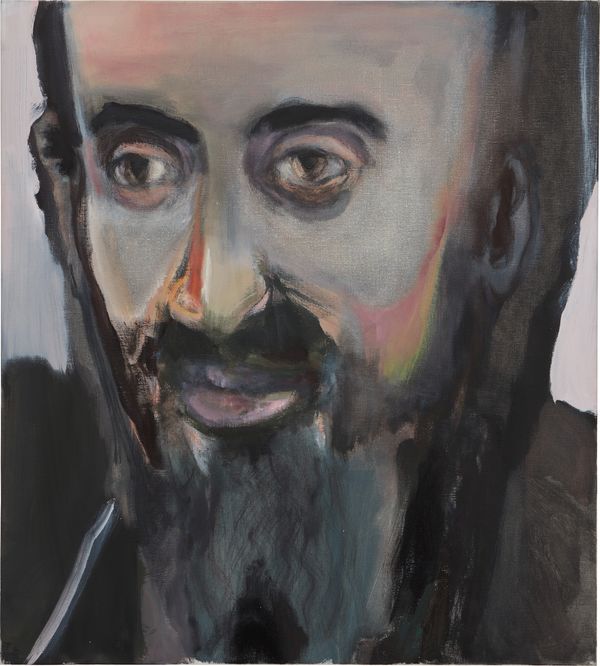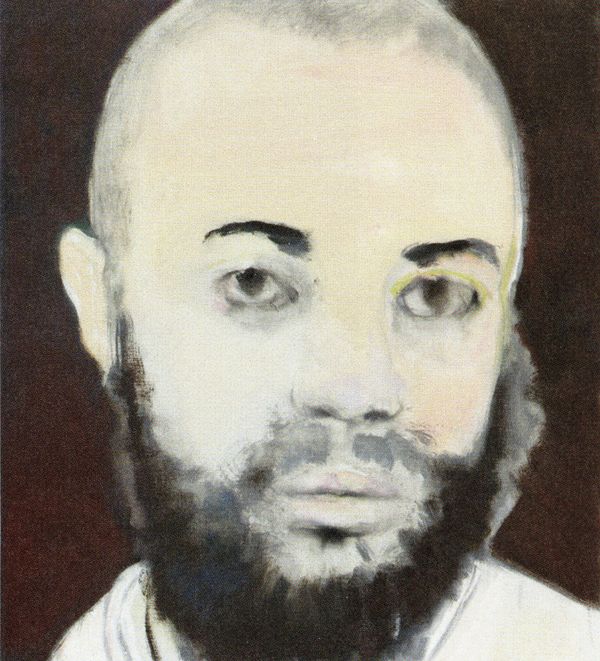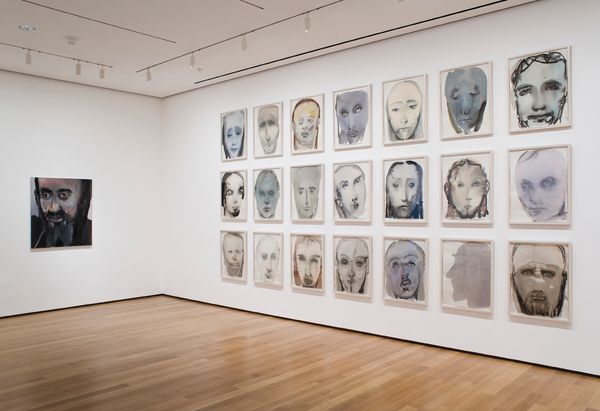Marlene Dumas The Pilgrim, 2006
The Pilgrim, 2006, is a tantalizing work by South African artist Marlene Dumas, one of the most prominent figurative painters working today. The painting was exhibited for the first time in the exhibition Man Kind at Galerie Paul Andriesse in Amsterdam in 2006, the same gallery where Dumas exhibited her very first series of portrait paintings The Eyes of the Night Creatures some 21 years earlier. As the optimistic days of The Family of Man — Edward Steichen's 1955 exhibition celebrating global solidarity — drew to a close in the wake of 9/11, Man Kind was Dumas' tribute to those who had influenced her work: the portraits of politicians, martyrs and murderers in the mass media. All part of the same kind. And as we know, man is not so kind.
The present work depicts a close-up of a bearded man, absent-mindedly staring into nothingness. Alone with his thoughts, he is difficult to read and an elusive character. The overall, brooding atmosphere is one of silence. Pink twilight softly glows on the man's face, the lush and vivid rose, orange and green brushstrokes on his forehead, nose and cheek standing in stark contrast to the bleak and greyish parts of his skin and the darkness surrounding him.
I knew the works looked like portraits, and the works were portraits to some extent; and yet they were not true portraits either.
— Marlene Dumas
The Pilgrim was not only shown in Dumas' acclaimed retrospective exhibition that travelled from the Museum of Contemporary Art, Los Angeles, to the Museum of Modern Art, New York, and the Menil Collection, Houston, in 2008 and 2009, it was also included in the extraordinary exhibition Tronies - Marlene Dumas and the Old Masters at Haus der Kunst, Munich, in 2010-2011. Exploring the art historical trope of the 'tronie' — a depiction of a face that is not necessarily a portrait but presents a stock character or exaggerated features — this exhibition presented select paintings by Dumas next to works by Rembrandt, van Dyck, Judith Leyster and other seventeenth-century masters. Pondering the notion of the tronie in relation to her first series of portrait paintings in the accompanying catalogue, Dumas recalled, as quoted in 2010, "when I painted my faces in 1985 – The Eyes of the Night Creatures – I knew the works looked like portraits, and the works were portraits to some extent; and yet they were not true portraits either."
Is The Pilgrim a portrait in the literal sense of the word? And if so, of whom? The title indicates no particular individual, but rather a type of person. Other paintings in these series have similar names, such as The Semite, 2006, or The Believer, 2005. Pilgrims undertake a journey, a pilgrimage to a holy place to find spiritual enlightenment or healing. They are believers, who, devoted to their faith, are prepared to endure physical misery for God's sake. There are all sorts of pilgrims: Catholics who travel the road of Saint James to Santiago de Compostela in Galicia, Spain; Muslims who confirm their faith with the Hajj, the pilgrimage to the holy city of Mecca in Saudi Arabia.
Marlene Dumas The Neighbour, 2005. Collection Stedelijk Museum, Amsterdam © Marlene Dumas
The Pilgrim may be compared to The Neighbour, 2005 (Stedelijk Museum, Amsterdam), which Dumas painted around the same time and in the same format as part of the Man Kind series. The picture depicts an ordinary young man, likely of North-African descent, with a short flaxen beard. He could be the guy next door. Indeed, ever since the migration of so-called 'guest workers' to the Netherlands in the 1960s and 1970s, a large community of people from Moroccan descent reside in Amsterdam, particularly in the area where Dumas, an immigrant herself, lives and works. The neighbor in Dumas' painting has been identified as Mohammed Bouakhri. Known in the press as 'Mohammed B.', he was arrested and convicted in 2004 for the murder of Dutch filmmaker and journalist Theo van Gogh (who, coincidentally, descended from Vincent van Gogh's family). Theo van Gogh was murdered in Amsterdam on a Tuesday morning and was left with a written statement pierced onto his chest. Giving the appearance that the murder had been motivated by fundamentalist religious beliefs, the brutal assassination caused great social turmoil within the Netherlands — heightening feelings of fear, xenophobia and Islamophobic sentiments. Considering the person depicted by Dumas in The Neighbour, nothing in his gentle and calm expression indicates that we are standing face to face with a terrorist. The picture counters the subliminal suspicion that every bearded man of North-African descent is a potential terrorist, a notion widely spread by the media at the time.
When The Pilgrim was exhibited together with The Neighbour at Galerie Paul Andriesse, it was notably not shown in the exhibition space itself, but in the gallery office. Perhaps the picture was thought to be too controversial. Looking at this anonymous pilgrim, one is easily tempted to recognize in his face the features of Osama bin Laden, the world's most wanted terrorist back in 2006. By then, Osama bin Laden was already in hiding for years. While there were not many pictures of him in circulation, the few images that were available were ubiquitous.
The Pilgrim exhibited in Marlene Dumas: Measuring Your Own Grave, The Museum of Modern Art, New York, 2008-2009 © Marlene Dumas The Museum of Modern Art/Licensed by SCALA / Art Resource, NY
In her image archive, Dumas held a photograph that depicted two indigenous people from the inlands of New Guinea wearing T-shirts with a print of Osama bin Laden's face on it. The photograph of Osama bin Laden that Dumas has appropriated as the source material for The Pilgrim is well known, as it was, and still is, published around the world. In this image, the enemy of the state looks rather handsome and attractive — unlike Charles Manson, with his bewildered and furious gaze; unlike Adolf Hitler, with his moustache. Dressed in white, Osama bin Laden has the charisma of a Jesus-figure (though nobody knows what Jesus looked like in reality, his image has been constructed from countless imaginations across the centuries). Frozen in time in this particular portrait, bin Laden remains 33 years of age forever. Sometimes a portrait becomes the icon for the spirit of an era — epitomized best by Che Guevara's black and white portrait that summarizes the revolutionary spirit of the 1960s. As Dumas ironically observed, as quoted in 2012, "now radical Islam too got its representative face, be it against all Islamic laws."
While Jesus became the Christian icon of all-encompassing Love, the face of bin Laden has become the prime expression of Hate. In her paintings and drawings, Dumas rarely addresses such volatile subject matter directly, instead surrounding her subjects with a veil of ambiguity. In her oeuvre, you won't find paintings directly based on notorious photographs from Ground Zero, Abu Ghraib or Guantánamo Bay. As Dumas wrote in a statement for the exhibition catalogue for the Man Kind exhibition at Galerie Paul Andriesse:
'We travel in disguise,
so how would you know
friend from foe?
The devil is back, as two-faced
and as polarizing as ever.
Who's side you are on
depends on where you're from.'
Yes, The Pilgrim might represent Sheikh Osama bin Mohammed bin Awad bin Laden, founder of Al Qaida, hero of the Afghan War against the Russians, mastermind behind the 9/11 attacks. And then again, it might not. A smaller portrait painted by Dumas in 2010, which now resides in the collection of the Stedelijk Museum, Amsterdam, is entitled Osama, leaving no doubt about the identity of the sitter. While the initials of 'OBL' on the reverse of The Pilgrim serve as a quiet nod to the potential connection to the sitter, Dumas nevertheless leaves room for doubt by addressing the issue of likeness — a notion of course central to the art of portraiture, but also to all areas where identification of a person is cardinal. It speaks volumes that one of the portraits in the Man Kind series is called The Look-alike, 2005. Iraqi dictator Saddam Hussain employed a lookalike for safety reasons — an amazing double, only recognizable by his left ear. Saddam is one of the four persons portrayed by Dumas in a series of small drawings entitled The Politics of Recognition, 1993, the other three being Adolf Hitler, Martin Heidegger and 'a murderer,' which is, in fact, a drawing after a painting by Jean-Louis Theodore Géricault. We can never be sure of whom we are really looking at. In the impressive oeuvre of Marlene Dumas, The Pilgrim addresses the uncertainty of portraiture like no other work.
Dominic van den Boogerd is an art critic. The former chief editor of 'Metropolis M', he is the current Director of De Ateliers in Amsterdam. Among many publications, he co-authored the Phaidon monograph on Marlene Dumas.


